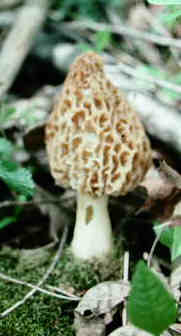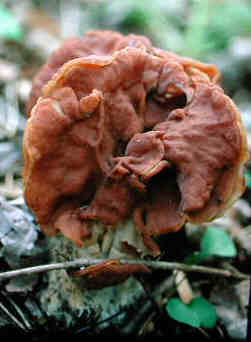| 04-01-02
Early finds of morels--though smallish--were recorded last week in the
southern part of the state, but that vanguard of gastronomic delight leaves
no doubt that the spring mushroom season is here.
Anyhow, my calendar says April 1 and that, alone, is enough to make
it so.
There is plenty of moisture in the woodland floors now, so all we need
are some bright sunshiny days and humid nights.
Having established the fact that morel time is here, the next issue
for many morellers may revolve around the possibility that someone may
be confused separating morels from false morels.
The problem here (as I see it) lies in the fact that various segments
of the media (including some mycological experts) have never held a false
morel in their hot little hands. It may be good that these folks urge morel
hunters to be cautious about the mushrooms they pick and eat. But I fear
this may discourage some mushroom hunters unjustifiably.
Sure, you want to be cautious about fungi that you eat, but anyone who
thinks a false morel even remotely resembles a true morel had better schedule
an appointment with his friendly eye doctor. There is little resemblance
between the two.
There are several false morel species, also called the brain mushroom
because its cap looks somewhat like the human brain. They are said to be
poisonous--especially raw--but I have eaten the species we call the elephant
ear and know of many other people who have consumed this species. Still,
I would have to be pretty hungry for mushrooms to eat that mushroom today.
Be that as it is, there still is no way to confuse the false morels
with the true morels.
The false morel we see here most often is Gyromitra infula which
usually occurs about the time the morel season shifts from small grays
and blacks to big yellows (“yallers”). It usually is barn-red, or brown,
but I have seen them with grayish or dark tan caps. Flesh of the cap is
thin and brittle and the interior of the cap is made up of wrinkled chambers,
not one open chamber like the true morels.
In texture, the stem of the false morel is similar to the stem of some
members of the true morel family, but here, again, it has many chambers
while the stem of the true morels is open (not greatly unlike a soda straw),
though usually larger.
The exterior texture (the feel) of a false morel cap much reminds me
of the wet back of a soft-shelled turtle.
False morels may occur in many sizes. I have found and photographed
species that were no more than an inch wide, but I have seen pictures of
a false morel that was as large as a one-gallon paint bucket.
Still, however large or small false morels may be, there is no need
to fear them. Although I pick them only to be taken to a place that offers
better light and surrounding for making pictures, I often get belly-flat
and eyeball-to-eyeball with them just to see what they look like.
The false morel is another of nature's wonders--to be celebrated . .
. not feared.

|

|
|
True
Morel
|
False
Morel
|
|

